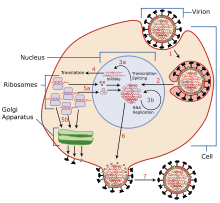Replication cycle
In virology, the replication cycle describes the cyclical sequence of development steps of a virus during a viral infection .
properties
The replication cycle during a viral infection consists of different individual steps: the adsorption of the virion on a cellular receptor , the invagination of the virion by endocytosis or direct penetration of the cell membrane (especially in bacteriophages ), a release of the virion into the cytosol , the unpacking of the viral Genome , replication of the viral genome, and protein biosynthesis of viral proteins . With persistent infectious agents there is often a stage of virus latency . After the biosynthesis of the viral genome and the viral proteins, the newly formed virion is aggregated and occasionally further matured through post-translational modifications . Upon maturation, the newly formed virions are released through the cell membrane, either by budding or by cell lysis , depending on the virus . The newly formed and released virions can then infect other cells, which starts the replication cycle again.
Individual evidence
- ^ Brian WJ Mahy: Encyclopedia of Virology . Academic Press, 2008, ISBN 978-0-123-73935-3 . P. 147.
